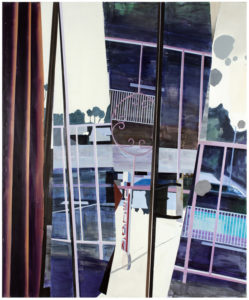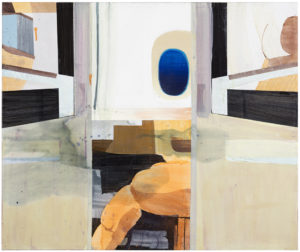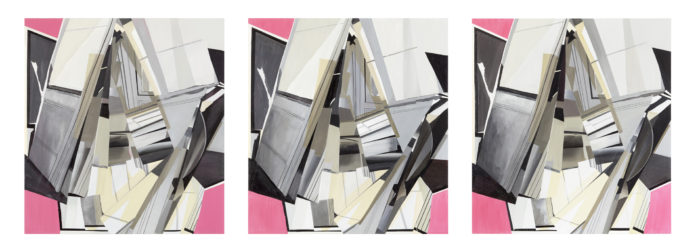The Events of Visuality: Three Works of Harri Monni — No Particular Place, Inside/Outside, and One builds what one no longer knows
by Prof. Steven Dixon
by Prof. Steven Dixon
The Events of Visuality, Prof. Steven Dixon
Tyglat kaos, Omkonst, Leif Mattsson
It is common practice when critiquing an artist’s visual work to first begin with a description of the artistic object and then ponder the connections, materials and meanings of the work. When viewing the work of Harri Monni, however, a different tack is necessary. What is not seen, what is cut off and hidden from being grasped in the perceived, what frustrates the viewing, and, therefore, what circumvents the attempt to utilize this basic descriptive approach of evaluation towards the art object is what holds sway in the understanding of the work here. In the logic of the Monni surface the continuous pathway of the line, the unaccomplished presentation of the shape, the imaginary totality of the object, and the very location of the framing is secreted and undone in the operations and activities of the painting.
Any understanding of Monni’s work must begin with this realization. With this realization comes an awareness that each the line cut, all architecture interrupted, every space folded under is presenced by a clandestine affective intensity calling to complete the line/shape/space.
To complete the journey of the visible into the invisible and, therefore, make the unseen understandable. Yet as every new push to complete the assemblage of the seen (the line, the shape and the space) remains itself a fresh unfulfilled ground of lingering and questioning intensities, the Monni logic always resolves itself to an unremitting suggestion of continually another form and always a different place. The apparent, as well as the secret, affects moving within the Monni painting beacons us to a travel beyond completion, a dance of understanding beyond the status of totalities, a lingering whisper for open fields.
Never quite closing down perception and sensation in mere confusion, this subtle unresolved space, laid out in the intensities of the unseen, opens up the perceptual landscape to the many and the infinities of places possible. The release of subtle affective intensity within the dynamics of Monnis work abolishes the cloaked reality created by walls and the coerced directions imposed by walkways and, instead, point’s perception towards the open and released multiplies of direction and connection. Every confrontation of the surface of the Monni painted work manifests itself as a perceptual attempt to grasp the elusive explications of the invisible, hidden relations which lay beneath the visual and pushes the readings of the sensible towards a understanding of obscure connections laid out in the multiple of all surfaces and spaces. In this confrontation of the dilemma of sensible and understanding, reading and perception, the seen and the unseen, the chaotic structures of the Monni painting expose the multitude and diversity of visualities. The affective tensions obviously resonating in the play of the multiple surfaces (and framings) of the work, and the sensations caught up in the vibrations of the unfulfilled and unresolved, are the primary sensible and conceptual components of the Monni surface.
Each dissatisfaction, founded on the impossibility of closure of structure and surface, and a blinding insight of meager understandings which always hope to accomplish an understanding of the entirety of the innumerable possible visualities (including levels of visuality), implied within the work, indicates a new linage of visuality, both internally consistent and undermined simultaneously. The recognition of new visualities erupting on the Monni surface expresses itself as materializations and understandings while the affective intensive machine of the interrupted Monni line and plane, rematerializes as unremittingly new and alternative architectures and spaces. This much is readily apparent. However, the question of inside and outside is also in question as we have seen in the vacillations of resolutions and understandings. Toward this end, Titling is used by Monni to underscore this open logic of the surface and the space, one which even surmounts the inside and outside of the painted work. This titling, as opposed to locking down and securing a singular meaning and operation of the art piece, insures, in its stead, that no specific and, therefore limited and determinate, structure is imposed on the work. As he notes *about his painting “No Particular Place”
“No particular place”
the starting point for them is
a picture from a magazine that I have
used
over and over again.
Letting the wear out look
and color fading
be part of the painted image
the taping and the drips of paint
as sort of timeline
pondering of the process itself
what is the “motif”
or is there something as a painting
that is a more result of the studio work,
a “ final”
or an achievement
of some kind.

The titling mirrors the unresolved of the surface as the name enters into the piece yet comes to no resolution either as outside determinate or inside resolving of the meaning. The operation of titling operates as further mechanism of vacillation of visuality and border in the Monni work. Both subsumed (is subsumed as singular with the meaning) and separated (is separate as explaining how to apply an open reading) without resolution. Each consideration of the boundary, which includes frame and title, operates as a logic and material of the piece which can only conclude in an open question of the differing visibilities and, therefore, altering the boundary, i.e. frame. Each visibility, as boundary, generates a unique different set of objects, borders, values, systematic, disciplines, logics and sense. Never a place to be settled upon or a set of relations imposed, the vectors of intensities and the release of visualities becomes a machine of questioning which is reflected in the operation of the Monni art work as an opening. One possible of all possibilities enumerated and called upon in the work and in a constant evaluation of the border it entails.
As opposed to the status of being, the unresolved of becoming, the plying of the multiple formulated in the affective intensities created by the Monni painted field, continually opens the work to reevaluation and dematerialization in haunting formlessness of the work. Where the lines are cut, and planes are severed is where open reading and visualities come to play in perception propelling a vigorous formlessness always coming to haunt the most stringent of forms. The incommensurate, but inseparability of the chaos and form, produced through the open of multiplicities of intensities, marks a last release to the open on Monni’s multiple surfaces. This dual bounding of infinity/finite, form/unformed is discharged through resonant intensities of incompleteness of the canvas becoming an undermining, and simultaneously, a formulation of new forms from the refuse of the formless. A field of vying visualities (that is forms which may, or may not, come together as objects) is activated only by the many pulls and pushes of the formless creating an open field for the formulation and dissolutions of objects, events, borders, meanings, and understandings.
And though this ultimate connective dilemma of the form and the formless, may clarify the mechanism Monni uses to populate his realm of meanings, still one more step is necessary for the work to unfold in the intensive fields of the visual. For in every precarious clarification of the art piece, every formed object which dissolves to another, every space questioned and dissipated, it becomes obvious that the understanding propounded in the Monni procedure emphasizes an unceasing becoming, a place where continual confrontation of work is necessary. Each resolution will fall to the wayside in every confrontation with an alternative solution. The contradictory resolution of the Monni visuality resides in the creation of formlessness from the last form and in motion towards only the tentative new arrangement and formulation founded on dissolution and dissipation. Moving on is the only object. Motion predicated in the bonding of form and formlessness lays bare the full becoming of the Monni surfaces, and the underscore the always perpetual activity that is prerequisite of the all objects and space. The motion laid bare in the unresolved of the multiple visualities of becoming on the Monni surfaces points us to a meaning open and flowing between object and event, the formed and unformed, made and found, understandable and incomprehensible, and, of course, seen and unseen.


As Monni notes, the open avoids all traps of the closure through the active events of becoming:
“I am now working on a painting”
that is not yet ready
and after that there must be another…
Maybe it is a trap
but it seems to be what I can do now.
*Authors Note: These Poems where formulated directly from Harri Monni’s information about his work via email. I have structured them in this format to highlight the insights which I think Monni meant to convey.